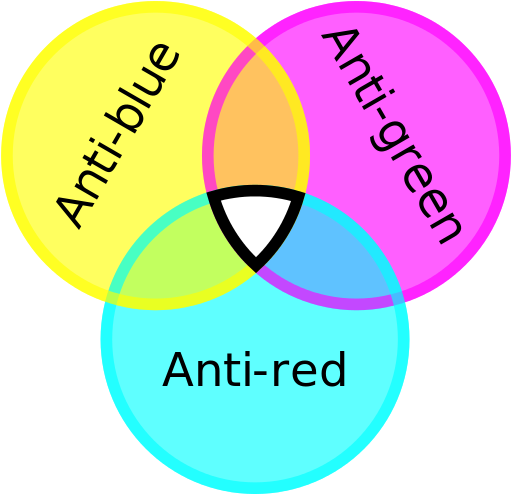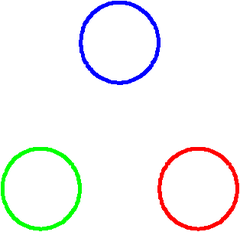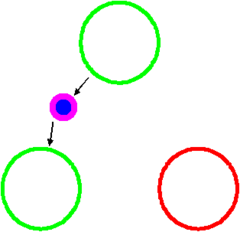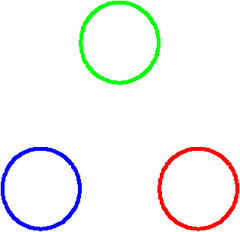Particle Physics, Part 2: Colourful Quantum Chromodynamics
Posted by Youssef Moawad on: 23/04/2017, in Physics
Where were we?
In part 1 of this series, I introduced the Standard Model and the four fundamental forces that govern our universe on a quantum scale. You may recall the four fundamental forces to be:
- The Electromagnetic Force which is responsible for the interactions between charged particles
- The Gravitational Force which (appears to be)* responsible for interactions between particles with mass
- The Strong Nuclear Force which is responsible for keeping nuclei intact
- The Weak Nuclear Force which is responsible for radioactive decay
We learned about the number of different particles that the Standard Model predicts to be the building blocks of our universe. We also very briefly discussed bosons and started talking about the strong nuclear force.
In this part, we will mainly talk about this force, the strong nuclear force, which is mainly responsible for the interactions between the quarks in the protons and the neutrons inside the nucleus. We will also discuss the theory of quantum chromodynamics which is the quantum theory that describes how the strong nuclear force works on the level of quarks.
I hope you enjoy this part and find it informative!
Colour Charge
Much like the electromagnetic force explains the interactions between particles with electric charge like the electron and the proton (and quarks themselves), the strong force explains the interactions between particles with colour charge.
We say a particle is coloured if it has a colour charge. While there are only two electric charges (positive and negative) and they can combine to make a neutral electric charge, there are three colours that a particle can be: red, green and blue. Keep in mind that this is essentially just an analogy that physicists like to use. The colours actually do correspond to mathematics that more accurately describes how the strong force works, but this is well beyond the scope of this series. The particles are not actually coloured!
So a particle can have a colour charge of red, green or blue. However, a particle can also have a neutral colour. In fact, if the three colours combine, they form a neutral "white" colour, much like colours in everyday life.

The three colour charges. Notice their intersection represent them combining to form white.
Image from Wikipedia
In addition to the three colours, red, green and blue, there also exists an anticolour corresponding to each of these colours: antired, antigreen and antiblue. These anticolours are sometimes referred to as cyan, magenta and yellow but for clarity we will be sticking with using the prefix anti to refer to anticolours. The three anticolours also combine to form the neutral white colour, as you would expect.

The three anticolour charges (represented as cyan, magenta and yellow). Notice that the anticolour appears in the diagram in the opposite place as its corresponding colour in the above diagram.
Image from Wikipedia
It is relevant to also note that much like positive and negative electric charges combine to form a neutral electric charge, colour charges can combine with their anticolour to form a neutral colour charge (white). So for example, a red charge can combine with an antired charge to make white. This is much like how red combines with cyan to form white in everyday life.
So what if you only combine two colours? If we only consider two colour charges combining (both are normal, not anticolours), then the resultant colour charge is the anticolour charge of whatever the third colour is. This will be more clear in this example. Say we're combining red and green, then the resultant colour is antiblue (which is yellow in normal colours). Now if we go back to combining three colours: red, green and blue then we can think about it this way: red and green will combine to form antiblue, which in turn combines with the blue to form white. This is one of the really cool properties, in my opinion, about colour charge. Alternatively, we can think about it as green and blue combining to form antired which then combines with red to form white. There is also a third way which you should be able to figure out!

In this image, fields from colour charges are shown. You can see a field that confines three different colours together and field that confines three anticolours togethers. There are also fields that confine each colour to its corresponding anticolour. These effects are the ones responsible for holding quarks in baryons (protons and neutrons) and mesons, but we'll learn more about this later.
Image from Wikipedia
Interlude: short break from the physics
I've probably talked about colour charges more than is necessary for you to understand quantum chromodynamics. But I think that the symmetries described above are quite cool to know and think about. This was definitely another one of the things that caught my attention to the Standard Model. I was just fascinated by how such a physical phenomenon, that I couldn't possibly hope to understand at the time, can be modelled so well and so elegantly by something as simple as colour.
Coloured Particles
Now that we have discussed the nature of colour charges and how they combine, we can start considering particles that can have the property of colour charge. In the Standard Model, only quarks and gluons carry colour charge and because the strong nuclear force only acts on particles with colour charge, only quarks and gluons are involved here. So take a backseat, leptons, the focus is off you!
Coloured Quarks
Let's start with the simple case: quarks. A quark (any quark) always has one colour charge: red, green or blue. This means an up quark can be red, blue or green, so can a down quark, a charm quark and so on. Similarly, an antiquark has one anticolour charge: antired, antigreen or antiblue. Now, recall from part 1 that a proton is made up of three quarks. The proton needs to be neutral with respect to the strong force, i.e. it needs to have a total colour charge of white. From what we learned about 3 colours combining above, this means that at any one time one of the quarks needs to be red, another needs to be blue and finally the third one needs to be green. I say at any one time because the colour of the quarks continuously cycles in a process known as gluon exchange, but we'll see more about that later. As you can guess, neutrons also need to be colour neutral and indeed the same regarding the quark colours applies to neutrons.
Mesons
Now, in part 1, I introduced a type of particles called the baryons, the most common examples of which are protons and neutrons. The defining property of baryons is that they are made up of three quarks (similarly, antibaryons are made up of three antiquarks). There is another type of matter called the mesons, that might be a little less familiar. A meson is a particle that is made up of a quark-antiquark pair. Bear in mind that the quarks do not need to be of the same flavour for the meson to exist. Common mesons include the positive kaon which is made up of an up quark and an antistrange quark. A multitude of different other mesons exist but we're here just to consider their colour charges. Like the baryons (protons and neutrons discussed above), mesons also need to have a total neutral colour charge. For a quark-antiquark pair, this is not hard to think about. If, for example, the quark has a red colour charge, then the antiquark must have an antired colour charge. Similarly, a meson can also be green-antigreen or blue-antiblue.
Gluons
You may recall from when we discussed force mediators in part 1, that the gluon is the force mediator of the strong nuclear force, so it should come as no surprise that it plays a big role in quantum chromodynamics.
Unlike quarks, which only carry one colour charge, gluons carry a colour-anticolour charge pair (for example green and antiblue or blue and antired). Keep in mind that unlike mesons, these are not two individual particles but rather one particle that is simultaneously carrying two colour charges (a colour-anticolour pair). Now, this means that there are actually different types of gluons out there comprising all the different colour-anticolour combinations. Intuitively, you may think there are nine types of gluons, however as a matter of fact, there is only eight.
The reasoning for this comes down to the mathematical model of the gluons and how the colours combine. This is described by group theory and is well beyond the scope of this blog series. For the purpose of this article, only six of the eight types of gluons will be required to think about. These six gluons are shown here:
| Gluon colour composition |
| Red + Antiblue |
| Red + Antigreen |
| Green + Antired |
| Green + Antiblue |
| Blue + Antired |
| Blue + Antigreen |
Indeed, the six states we're considering here are not actually six of the eight states that are mathematically possible. But for now, it will be easier to understand gluon exchange if we only consider these states. Just to give a very brief word on this, these six gluons actually represent only three of the eight states because, for example, the red-antiblue and the blue-antired states are considered just one of the eight gluons. This seems quite confusing but this is all because of the maths underlying quantum chromodynamics and because of the principle of superposition in quantum mechanics, which we will probably be talking about in a later article.
The reason states like red-antired, blue-antiblue and green-antigreen are not considered is because these are generally considered the same state as they all represent a white neutral colour charge. So they are not very helpful when discussing the phenomenon of gluon exchange, which we'll be talking about next.
Gluon Exchange
Having considered colour charges, coloured quarks and coloured gluons, we are now ready to have a look at a very important phenomenon that underlies quantum chromodynamics, that is gluon exchange.
Gluon exchange is the process that mediates the strong nuclear force between individual quarks. It is the phenomenon responsible for three quarks being confined to form a baryon and for a quark-antiquark pair being confined to form a meson.
Let's start by considering the case of three quarks forming a baryon. To start with we have a red quark, a green quark and a blue quark (the actual flavour of the quarks in this case does not matter). Essentially what happens is that the quarks emit a gluon (which changes the quark's colour) to their neighbour which then absorbs the gluon, changing its colour. The colours change because in any emittance or absorbance of a gluon, the total colour charge must be conserved.
So for instance, a red quark can emit a red-antiblue gluon only under the condition that it then becomes a blue quark. To verify colour charge conservation, let's look at the total colour charges before and after the emittance. Before the gluon is emitted, only the red colour charge of the quark was there, so the total colour charge was just one red. After the emittance, the quark became a blue quark and a red-antiblue gluon was emitted. We can add up these colour charges to find the total colour charge: blue + red + antiblue = red because the blue and the antiblue cancel out. So indeed the total colour charge before and after the emittance is the same.
We can expand this example by considering the absorbance case as well. Say the red quark becomes a blue quark emitting a red-antiblue gluon towards a blue quark. The blue quark absorbs the red-antiblue gluon becoming a red quark. This case is easier to understand than emittance because you can immediately see that the blue charge of the quark cancels with the antiblue portion of the gluon leaving the only option being that the quark becomes a red quark. You can do similar analysis to the above to verify colour charge conservation. Before absorbance, the colours in the system were red + antiblue + blue = red. After absorbance, only the red quark remained leaving the total colour charge to be red which is indeed what the total colour charge was before the absorbance.
This process is demonstrated in these diagrams:

The system starts with three quarks all of different colours: red, green and blue.

This step shows emittance. The blue quark (top in the previous diagram) has emitted a blue-antigreen gluon leaving behind a green quark. The gluon moves towards the green quark.

This step shows absorbance. The green quark (bottom left in the previous diagram) has absorbed the blue-antigreen gluon becoming a blue quark. This is the end of this gluon exchange process. Notice that the colour combination of the entire system is same after the process as before and indeed the total colour charge is white.
Images from Wikipedia
This gluon exchange process happens between all three of the quarks in turn, and is happening all the time to bind the quarks together causing protons and neutrons to form and in turn all of matter! This phenomenon results in quark confinement which is demonstrated for a neutron here:

Continuous gluon exchange resulting in quark confinement in a neutron.
Image from Wikipedia
Gluon exchange in mesons
A similar process to what is described above for baryons happens to confine quarks in mesons. Recall that a meson is a quark-antiquark pair where the colours of the two particles are always colour-anticolour pairs (i.e red and antired, blue and antiblue or green and antigreen). Consider the example of a meson starting as a blue-antiblue quark pair. Gluon exchange happens by the blue quark emitting a blue-antired gluon leaving behind a red quark. The antiblue quark then absorbs the blue-antired gluon becoming an antired quark. The remaining meson is now a red-antired quark pair. I leave the process of confirming that colour charge is conserved as a short exercise to the reader.
This process can also happen the other way, where the antiblue quark starts by emitting a red-antiblue gluon leaving behind an antired quark. The red-antiblue gluon is then absorbed by the blue quark leaving behind a red quark. Again, you should be able to confirm that colour charge is conserved in this process.
The process of gluon exchange provides explanations for how the strong force is mediated on a quantum scale and how it operates. This is arguably one of the most important physical phenomenon as it results in quark confinement which is how quarks combine to form all kinds of matter!
Conclusion
The aim of this article was to give you a brief idea of the underlying physical phenomena of the theory of quantum chromodynamics, which is arguably one of the most important quantum theories because it explains how quarks essentially stick together to form bigger building blocks of matter. I hope I have done so in this article in an easy to understand and enjoyable manner.
Like part 1, we conclude with a recap. In this article, we discussed the three colours that particles can take on and their corresponding anticolours and we saw how these colours combine in different ways. We then saw examples of the particles that can have a colour charge. And finally, we discussed the very important phenomena of gluon exchange and quark confinement.
On a more personal note, I certainly remember the first time I learnt about colour charges and the process of gluon exchange. I remember being absolutely blown away by how elegant the process, that is essentially responsible for keeping everything we know intact, is. The exchange of colours between quarks in such a neat way had a very appealing aspect to me.
What's next?
This series is definitely not over! The next part of the series will most likely involve the theory of quantum electrodynamics which describes physical phenomena that we're probably more familiar with from our everyday experiences. However, I am considering taking a break from the Particle Physics series and writing an independent article regarding other physical phenomena that I find interesting (likely candidates right now include the double slit experiment and the principle of superposition). This will most likely be posted here in around a week's time.
Closing remarks
Many thanks for reading! I hope you have enjoyed this part of Particle Physics. Like always, your feedback is very much important and will help to improve future articles I write. So please feel free to drop a comment here or contact me through the website or through my my twitter: @_devdude. Thanks!
* more on this in a later post
Related
You may also be interested in:
Part 1: Why is the Standard Model so cool?